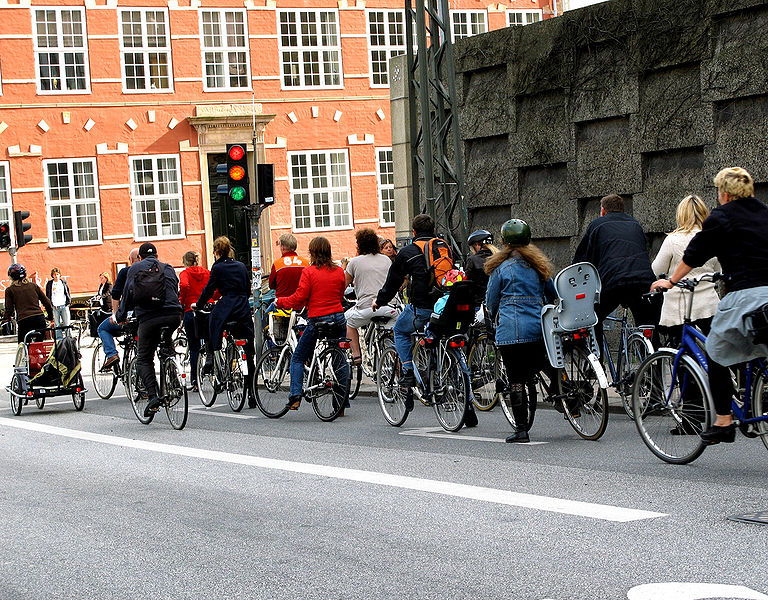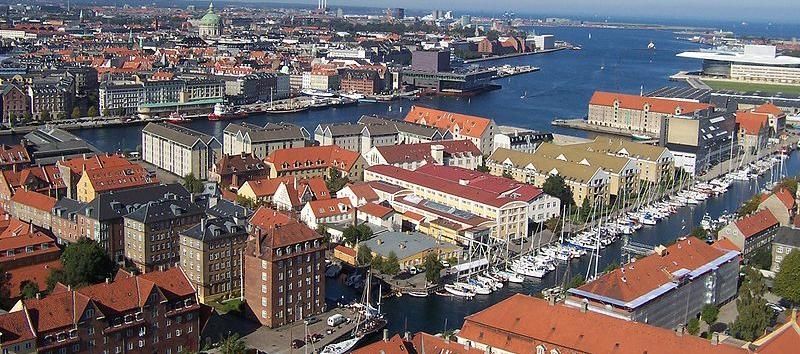The Danish capital, Copenhagen is moving quickly towards a zero-carbon future.
Wind farms, citywide efficient heating systems, energy efficiency, and the development of public transportation networks and bike routes are some of the initiatives helping the city in its aim to be carbon neutral by 2025.
Currently, 36 per cent of commutes to work or school in the Danish capital are made by bike, and more than 20,000 cyclists enter the city centre at peak hours, filling nearly 250 miles of cycle tracks.
Waste heat from power plants is also used to keep buildings warm via the world's largest district heating network.
Copenhagen's ambition to become the world's first carbon-neutral capital by 2025 will see further innovations and an even greater push towards energy efficiency and sustainability. Acting on a City Council plan approved in August 2012, Copenhagen intends to replace coal with biomass, to add more wind and solar electricity to the grid, to upgrade inefficient buildings, and to encourage even more use of bikes and public transit.
Copenhagen Lord Mayor Frank Jensen has explained that city residents are putting their own finances into low-carbon energy sources and has noted that nearly 50 per cent of the turbines in the Middelgrunden wind farm were funded by private Copenhagen shareholders.
Copenhagen has been lauded in previous years for significant progress in cutting carbon emissions and the figure is suggested to be 21 per cent from 2005 to 2011. The city currently emits about 2 million tons of carbon dioxide a year, and earlier initiatives were on target to reduce emissions to 1.16 million tonnes by 2025. The new plan approved last year will slash CO2 emissions even further, to about 400,000 tonnes by 2025. More time will be needed to wean private cars from fossil fuels. So Copenhagen plans to add at least 100 wind turbines to the grid over the next dozen years, and wind electricity not used in the city will be exported to other parts of Denmark to offset Copenhagen's remaining several hundred thousand tons of transportation emissions.
Nearly three-quarters of the emissions reductions identified in the 2025 plan will come by transitioning to less carbon-intensive ways of producing heat and electricity. The goal is a diverse but complementary clean energy supply: biomass, wind, geothermal, and solar. Wind turbines now supply 30 per cent of Denmark's electricity, and under a national energy plan passed last year that share is set to rise to 50 per cent by 2020.
 Though not as visible as Copenhagen's bicyclists and wind turbines, its heating and cooling infrastructure is playing a key role in slashing CO2 emissions. One of Copenhagen's most innovative infrastructure projects is the Adelgade cooling plant, sheltered within the brick-clad shell of a retired power plant in the historic city center. Opened in June 2010, the plant is the hub of the country's first district cooling network and a model of climate-conscious engineering.
Though not as visible as Copenhagen's bicyclists and wind turbines, its heating and cooling infrastructure is playing a key role in slashing CO2 emissions. One of Copenhagen's most innovative infrastructure projects is the Adelgade cooling plant, sheltered within the brick-clad shell of a retired power plant in the historic city center. Opened in June 2010, the plant is the hub of the country's first district cooling network and a model of climate-conscious engineering.
The Adelgade plant draws cool seawater from an intake pipe located near the picturesque Nyhavn Canal and then delivers the chilled water through insulated pipes to buildings; the pipes are located below ground in the same tunnels in which steam is distributed via Copenhagen's district heating network. Thomas Grinde, an engineer with Copenhagen Energy — a private firm owned by the city — took me on a tour of the plant. He said that every degree Celsius saved by pre-cooling with seawater saves 15 per cent on electricity at the site's absorption chillers. The city estimates that district cooling reduces carbon emissions by nearly 70 per cent and electricity consumption by 80 per cent compared to conventional air-conditioning.
Under the climate plan, district heating is to be carbon neutral by 2025. The Amager and Avedøre plants, which today burn a limited amount of biomass imported from Poland, Russia, Sweden, and the Baltic countries, will replace coal entirely with wood chips and straw certified as sustainable by the Danish Energy Association.
Copenhagen's pursuit of carbon neutrality also rests on its ability to meet demanding energy efficiency and transportation goals. Commercial and residential buildings are to reduce electricity consumption by 20 per cent and 10 per cent respectively, and total heat consumption is to fall by 20 per cent by 2025.
The city faces a major challenge though in making existing buildings more energy efficient as more than 70 per cent of Copenhagen's buildings were constructed before Denmark's energy efficiency standards were introduced. A common and significant hurdle that the city is facing on this issue is the landlord-tenant conundrum; many Copenhageners rent and neither tenants nor landlords have the resources to roll out a retrofitting programme on buildings.
The city will also invest in alternative fuels and there are plans to convert its bus fleet to hybrid vehicles running on biogas. The city has estimated that 20 per cent to 30 per cent of all cars and small trucks, and 30 per cent to 40 per cent of all heavy vehicles, will run on electricity, hydrogen, biogas, or bioethanol by 2025. By 2015, 85 per cent of the city's fleet of 1,000 small vehicles will run on electricity, hydrogen, or biofuels, officials say.
It is estimated that the city's 2025 Climate Plan will generate nearly $475 million and it is predicted that private funds and total investment could hit $4.78 billion over the same period, officials have said.







